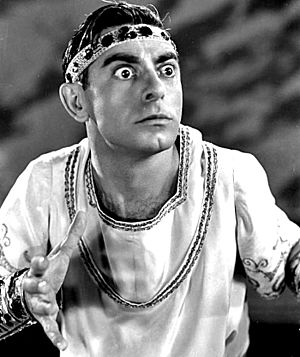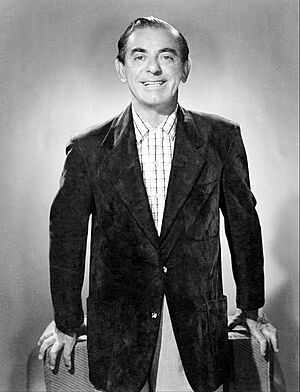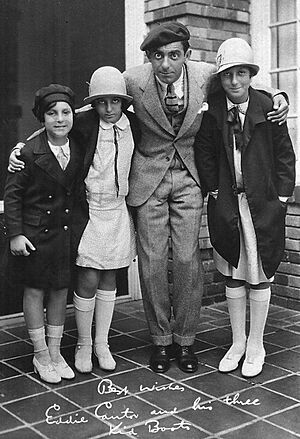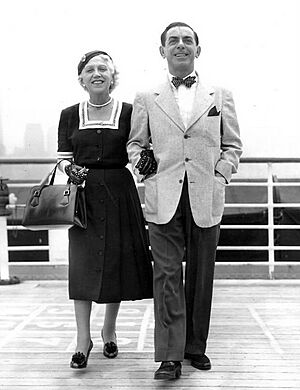Eddie Cantor facts for kids
Quick facts for kids
Eddie Cantor
|
|
|---|---|
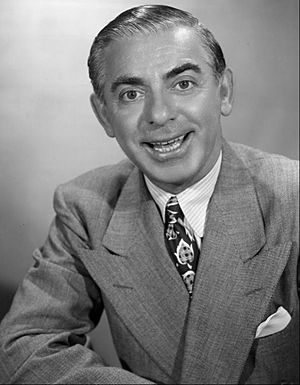
Cantor in 1945
|
|
| Born |
Isidore Itzkowitz
January 31, 1892 New York City, U.S.
|
| Died | October 10, 1964 (aged 72) |
| Resting place | Hillside Memorial Park Cemetery in Culver City, California |
| Occupation |
|
| Years active | 1907–1962 |
| Spouse(s) |
Ida Tobias
(m. 1914; died 1962) |
| Children | 5 |
| 2nd President of the Screen Actors Guild | |
| In office 1933–1935 |
|
| Preceded by | Ralph Morgan |
| Succeeded by | Robert Montgomery |
Eddie Cantor (born Isidore Itzkowitz; January 31, 1892 – October 10, 1964) was a famous American comedian, actor, dancer, and singer. He was also a songwriter, film producer, screenwriter, and author. Millions of people knew him from his shows on Broadway, radio, movies, and early television. He was known as the "Apostle of Pep" because he was so energetic.
His popular radio shows often shared funny stories about his wife, Ida, and their five daughters. This made many listeners feel like he was part of their family. Some of his most famous songs include "Makin' Whoopee", "Ida (Sweet as Apple Cider)", and "If You Knew Susie". He also helped write "Merrily We Roll Along", which became the theme song for the Merrie Melodies Warner Bros. cartoons.
Eddie Cantor's energetic song-and-dance routines and wide-open eyes earned him the nickname "Banjo Eyes". In 1933, an artist drew him with large, round eyes like a banjo drum. These eyes became his special trademark, often made even bigger in drawings. This nickname even led to him starring in a Broadway musical called Banjo Eyes in 1941.
Beyond entertainment, Cantor did a lot of work for charity. He helped create the March of Dimes and is even credited with coming up with its name. In 1956, he received an honorary Oscar for his important contributions to the film industry.
Contents
Early Life of Eddie Cantor
Eddie Cantor was born in New York City in 1892. His parents, Mechel and Meta Iskowitz, were a young Jewish couple from Russia. While some stories say he was an orphan, records show his mother died when he was young. His grandmother, Esther Kantrowitz, then raised him. She called him Izzy or Itchik, which were nicknames for Isidor. His last name was later changed to Cantor.
Stage Career
From Saloons to Vaudeville Shows
As a teenager, Eddie Cantor started winning talent contests in local theaters. One of his first jobs was singing for tips at a saloon in Coney Island, where Jimmy Durante played the piano for him. In 1907, he performed for the first time in Vaudeville in New York.
In 1912, he was the only performer over 20 in a show called Kid Kabaret. Later, he toured with Al Lee as a comedy team. His performances caught the eye of Florenz Ziegfeld, a top Broadway producer. Ziegfeld gave Cantor a spot in his show, Midnight Frolic, in 1917.
Broadway Stardom
A year later, Cantor made his big Broadway debut in the Ziegfeld Follies of 1917. He stayed with the Follies until 1927, which was a very successful time for the show. He performed alongside other famous stars like Will Rogers, Fanny Brice, and W. C. Fields.
Cantor then became a star in full musical plays. These included Kid Boots (1923) and Whoopee! (1928). While touring with Banjo Eyes, he met and dated Jacqueline Susann, who later became a best-selling author. The successful run of Banjo Eyes on Broadway ended early because Cantor had a heart attack. He would have more heart problems later in life.
Broadway Shows List
- Ziegfeld Follies of 1917 – performer
- Ziegfeld Follies of 1918 – performer, co-composer
- Ziegfeld Follies of 1919 – performer, lyricist
- Ziegfeld Follies of 1920 – composer and lyricist
- The Midnight Rounders of 1920 – performer
- Broadway Brevities of 1920 – performer
- Make It Snappy (1922) – performer, co-writer
- Ziegfeld Follies of 1923 – sketch writer
- Kid Boots (1923) – actor in the role of "Kid Boots"
- Ziegfeld Follies of 1927 – performer, co-writer
- Whoopee! (1928) – actor in the role of "Henry Williams"
- Eddie Cantor at the Palace (1931) – solo show
- Banjo Eyes (1941) – actor in the role of "Erwin Trowbridge"
- Nellie Bly (1946) – co-producer
Radio and Music Recordings
Radio Star
Eddie Cantor started on radio very early, appearing on a show in 1922. His big break came in 1931 when he joined The Chase and Sanborn Hour. This Sunday evening show made him a top comedian. He soon became the highest-paid radio star in the world!
His shows often began with the audience chanting, "We want Can-tor! We want Can-tor!" This chant started in vaudeville when audiences wanted him to come on stage. Cantor's theme song was "One Hour with You". He also helped start the careers of singers like Dinah Shore and Eddie Fisher.
In November 1934, Cantor introduced a new song on his show that other artists had turned down. The song was "Santa Claus Is Comin' to Town". It became an instant hit, with 100,000 copies of sheet music ordered the very next day!
His radio show Time to Smile ran from 1940 to 1946. He also hosted the Pabst Blue Ribbon Show and Take It or Leave It. In the early 1960s, he had a short radio segment called "Ask Eddie Cantor".
Music Recordings
Cantor began making records in 1917. He recorded both funny songs and popular tunes of the time. He recorded for many different companies like Victor, Columbia, and Decca.
After the stock market crash in 1929, Cantor lost a lot of money. But he used his writing skills to earn it back. He wrote popular, best-selling books of humor about his experiences, like Caught Short! A Saga of Wailing Wall Street.
Cantor was also a songwriter. In 1935, he helped write "Merrily We Roll Along". This song became the famous theme for the Merrie Melodies cartoons from Warner Bros. Pictures.
Film and Television Appearances
Eddie Cantor appeared in many films. He made short films of his Follies songs and comedy routines. He also starred in two silent movies in the 1920s. He was offered the main role in The Jazz Singer, but he turned it down.
He became a major Hollywood star in 1930 with the movie version of Whoopee!, which was filmed in color. He continued making movies for the next two decades. His last starring role was in If You Knew Susie (1948).
From 1950 to 1954, Cantor was a regular guest host on the TV show The Colgate Comedy Hour. He introduced musical acts and played funny characters. In 1952, he had a heart attack after a show and had to cut back his TV appearances. He continued to be a guest on other shows until 1960.
Cartoon Cameos
Eddie Cantor appeared as a cartoon character in many Looney Tunes cartoons by Warner Bros. He was often voiced by someone imitating him. You can see him in cartoons like I Like Mountain Music (1933) and Billboard Frolics (1935).
In What’s Up, Doc? (1950), Elmer Fudd ignores an animated Eddie Cantor. A common joke in cartoons was Cantor's wish for a son, since he had five daughters. In Slap-Happy Pappy (1940), a rooster named "Eddie Cackler" wants a boy chick, but keeps getting girls. An animated Cantor also appears in Walt Disney's "Mother Goose Goes Hollywood" (1938).
Books and Merchandise
Because he was so popular, many products were made with Eddie Cantor's name. These included the Eddie Cantor's Tell It to the Judge game. In 1933, a company published 12 different drawings of Eddie Cantor that businesses used for advertising.
Cantor was often drawn on the covers of sheet music and in magazines. He even had a balloon made in his likeness for the Macy's Thanksgiving Day Parade!
Besides Caught Short!, Cantor wrote or helped write at least seven other books. These books sold very well. Some people even said his books helped America recover from the Great Depression more than government efforts.
Helping Others: Activism and Charity
Eddie Cantor was the second president of the Screen Actors Guild, a group that helps actors. He served from 1933 to 1935.
He is famous for creating the name "The March of Dimes". This was for fundraising campaigns to fight polio, a serious disease. The name was a clever play on words from the popular The March of Time newsreels.
In January 1938, he started the first campaign on his radio show. He asked listeners to mail a dime to President Franklin D. Roosevelt. Roosevelt himself had polio. Other entertainers joined in, and the White House received 2,680,000 dimes! This was a huge amount of money at the time.
Cantor also recorded a special message on a 1938 music record. He thanked listeners for buying the record, as it helped the National Foundation for Infantile Paralysis. This record became a number one hit.
Tributes and Honors
Eddie Cantor was honored on the TV show This Is Your Life. He was the only person told about the "surprise" beforehand because he was recovering from a heart attack, and they didn't want to shock him.
In 1951, he received an honorary degree from Temple University. On October 29, 1995, Cantor was added to the Radio Hall of Fame in Chicago.
A movie called The Eddie Cantor Story was made in 1953. It tried to show his life, but some felt the actor playing him didn't quite capture his spirit. Eddie and Ida Cantor themselves appeared briefly in the movie's beginning and end.
A better look at Cantor's career can be seen in his own film, Show Business (1944). This movie was a tribute to vaudeville and show people, and it was a very successful film for RKO that year.
Personal Life and Family
Eddie Cantor changed his first name to "Eddie" when he met his future wife, Ida Tobias, in 1913. She thought "Izzy" wasn't a good name for an actor. Eddie and Ida (1892–1962) got married on June 6, 1914.
They had five daughters: Marjorie (1915–1959), Natalie (1916–1997), Edna (1919–2003), Marilyn (1921–2010), and Janet (1927–2018). Cantor often joked about his five daughters on his radio show, especially about them being "unmarriageable." Natalie's second husband was actor Robert Clary, known from Hogan's Heroes. Janet married actor Roberto Gari.
After their daughter Marjorie passed away at age 44, both Eddie and Ida's health declined. Ida died on August 9, 1962, at age 70. Eddie died on October 10, 1964, in Beverly Hills, California, at age 72, after another heart attack. He is buried in Hillside Memorial Park Cemetery, a Jewish cemetery in Culver City, California.
Filmography
- A Few Moments With Eddie Cantor, Star of "Kid Boots" (1923, short film) as Himself
- Kid Boots (1926) as Samuel (Kid) Boots
- Special Delivery (1927) as Eddie Beagle
- That Party in Person (1929, Short) as Eddie Cantor
- A Ziegfeld Midnight Frolic (1929, Short) as Himself
- Glorifying the American Girl (1929) as Eddie Cantor
- Insurance (1930, Short) as Sidney B. Zwieback
- Getting a Ticket (1930, Short) as Himself
- Whoopee! (1930) as Henry Williams
- Palmy Days (1931) as Eddie Simpson
- Talking Screen Snapshots (1932, Documentary short) as Himself
- The Kid from Spain (1932) as Eddie Williams
- Roman Scandals (1933) as Eddie / Oedipus
- The Hollywood Gad-About (1934, Documentary short) as Himself
- Kid Millions (1934) as Eddie Wilson Jr.
- Strike Me Pink (1936) as Eddie Pink
- Ali Baba Goes to Town (1937) as Ali Baba
- The March of Time Volume IV, Issue 5 (1937, Documentary short) as Himself
- Forty Little Mothers (1940) as Gilbert Jordan Thompson
- Thank Your Lucky Stars (1943) as Eddie Cantor / Joe Simpson
- Show Business (1944, also producer) as Eddie Martin
- Hollywood Canteen (1944) as Himself
- Screen Snapshots: Radio Shows (1945, Short) as Eddie
- American Creed (1946, Short) as Self
- Meet Mr. Mischief (1947, Short) as Face on Poster
- If You Knew Susie (1948) as Sam Parker
- Screen Snapshots: Hollywood's Happy Homes (1949, Documentary short) as Himself
- The Story of Will Rogers (1952) as Himself
- Screen Snapshots: Memorial to Al Jolson (1952, Documentary short) as Himself
- The Eddie Cantor Story (1953) cameo appearance and singing voice
Images for kids
See also
 In Spanish: Eddie Cantor para niños
In Spanish: Eddie Cantor para niños


